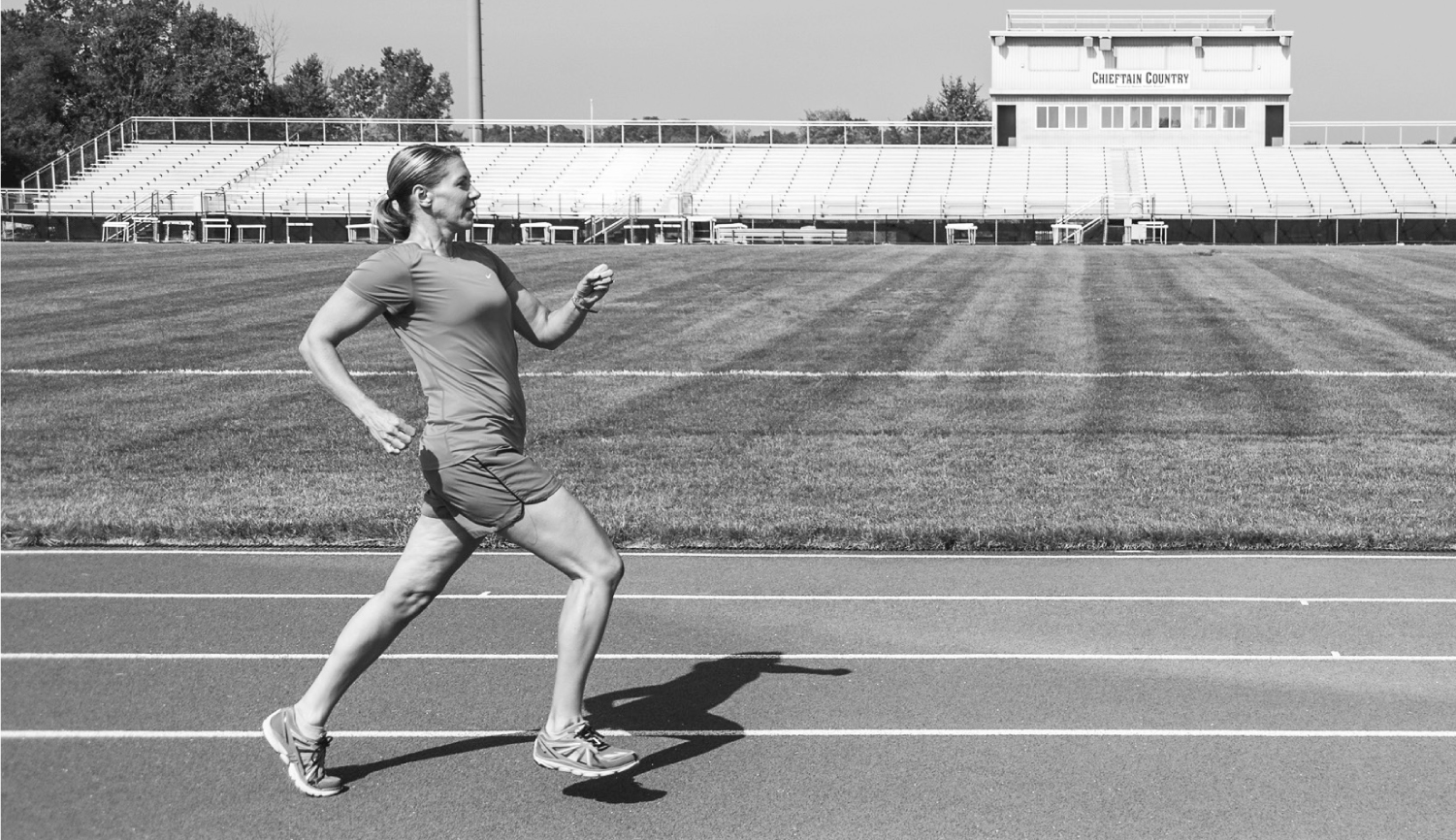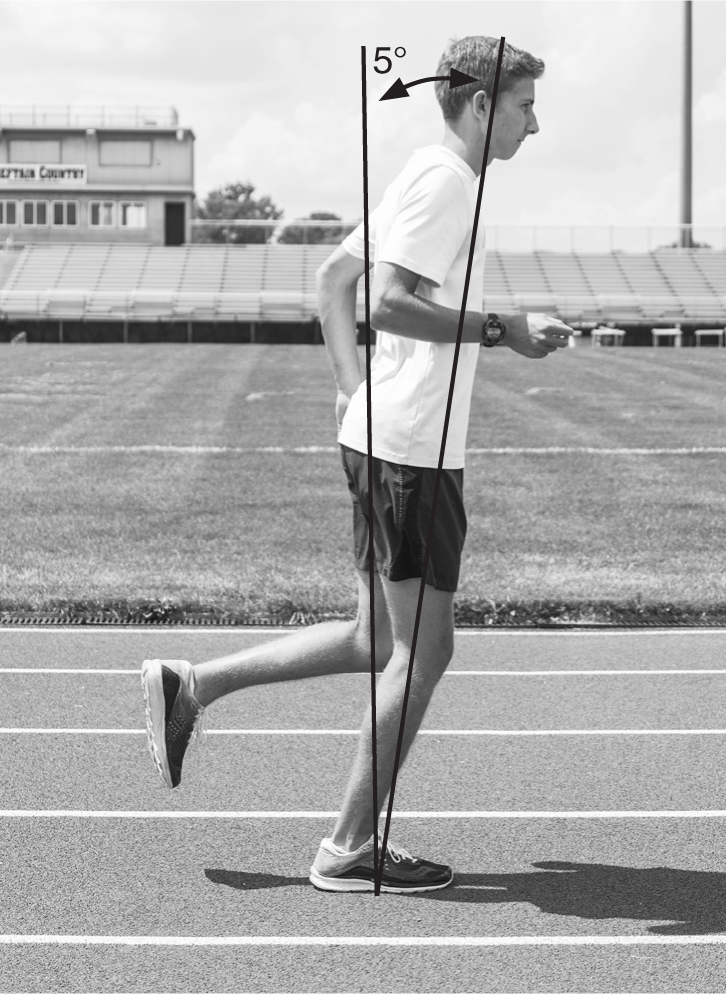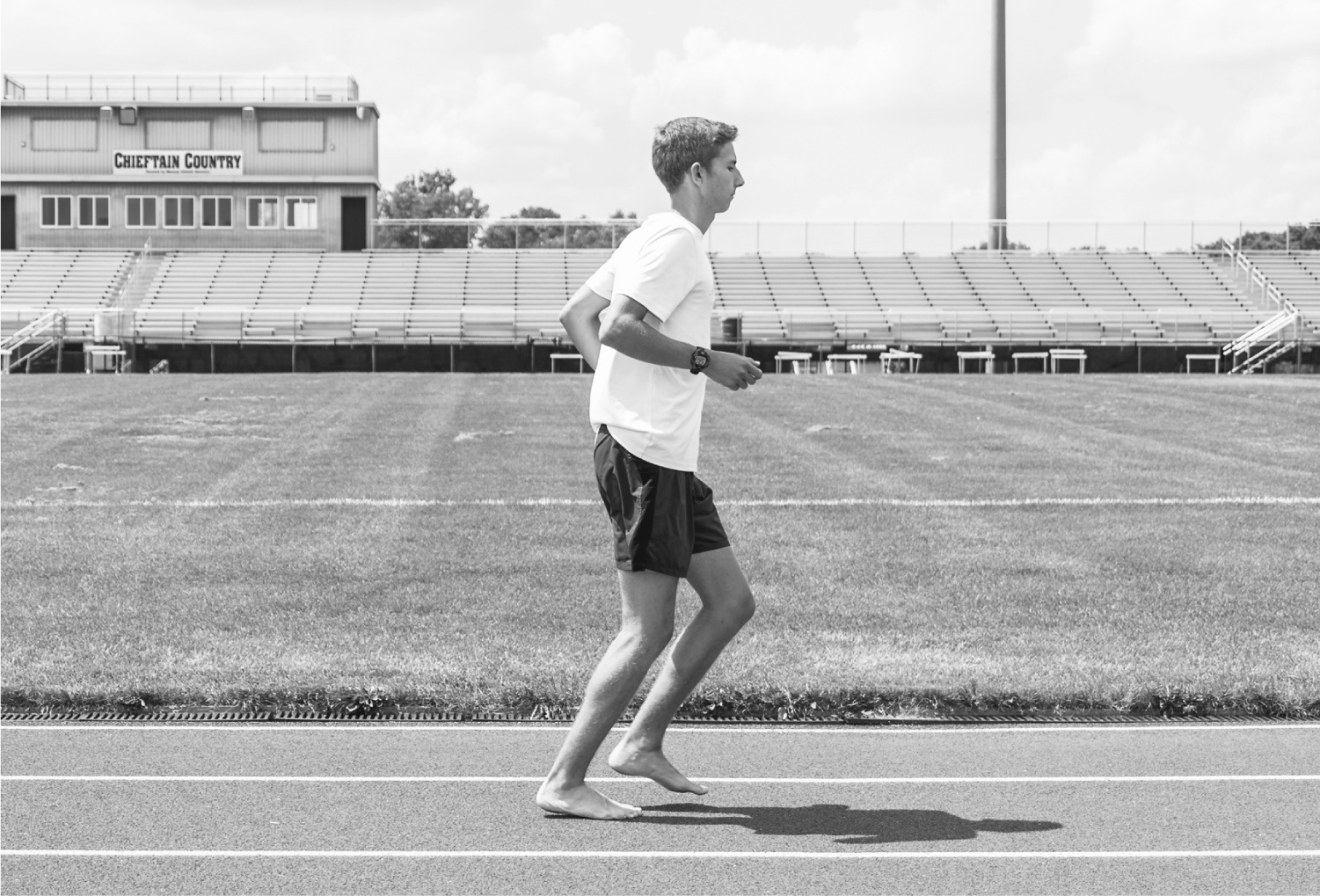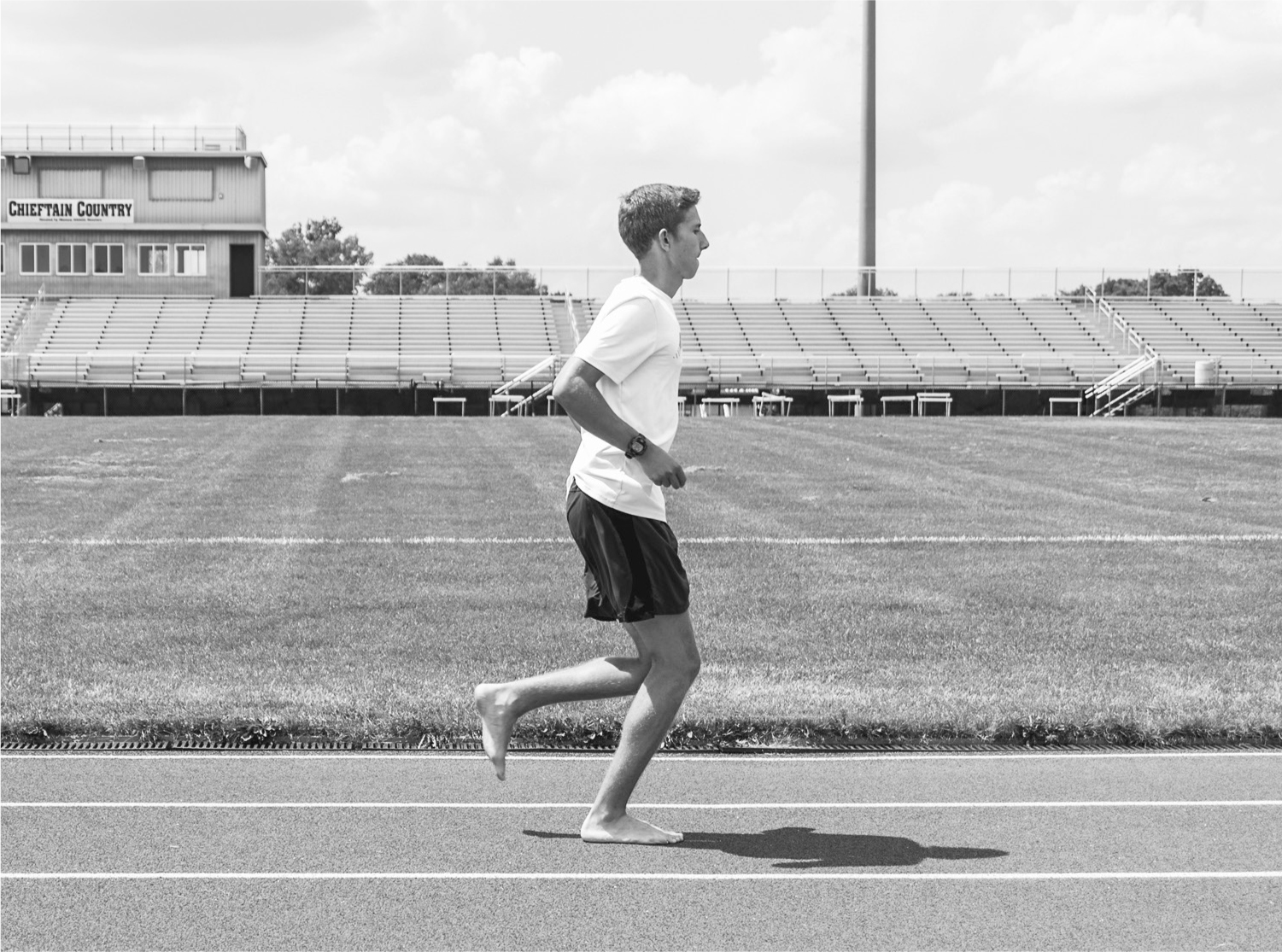9
Improving Body Lean
Chapters 4 and 7 explored how shank angle at touchdown (SAT) is critically important. If the shank angle is large and positive, a massive braking force is produced, which slows running speed. Large shank angle also tends to dictate heel-striking over midfoot- and forefoot-strikes, thus spiking loading rates of impact forces on the leg and increasing the risk of injury.
In contrast, a negative SAT reduces the magnitude of both vertical and horizontal propulsive forces and thus limits running speed. A shank angle that is barely positive (approximately six degrees) is linked with the best-possible running, from the standpoints of both performance and injury prevention. A six-degree SAT allows the leg to absorb and store impact forces during the first moments of stance, and then places the leg in optimal position to create the best possible vertical and horizontal propulsive forces (optimizing running velocity and economy).
Compared with shank angle, the effects of body lean on performance and injury risk are not as strong but are nonetheless important. Body lean can be defined as the position of the body relative to vertical at three key stages of stance:
- At initial impact with the ground
- At mid-stance
- At toe-off
There is little scientific research available to guide us toward the establishment of optimal lean, so logic and experience must prevail. Consider the effects of the three lean patterns on propulsive force during stance.
How Body Lean Impacts Running Velocity
Body lean at mid-stance—roughly halfway through the stance phase of gait, when the body is positioned more or less directly over the foot, the ankle is dorsiflexed, the knee is flexed, and the hip is also slightly flexed—is the time when maximal vertical propulsive forces can be created. This is partially because it is the natural, elastic extension of the ankle, knee, and hip that creates the propulsive forces required for forward movement.
To better understand the relationship between body lean and propulsive forces, imagine yourself lifting a large weight overhead. Would you have the greatest mechanical advantage and the largest lifting power if your body were leaning forward as you attempted the lift? Would it be best to lean backward as you moved the heavy mass? Obviously, you would have the greatest mechanical advantage and stability with your body in a vertical position (not leaning at all), and you could elevate the most weight with your body in a vertical placement.
However, this changes during running. Instead of lifting a weight overhead, a runner reacts with the ground to produce both vertical and horizontal propulsive forces. Picture three mid-stance scenarios:
- Applying force to the ground with the whole body leaning backward
- Applying force to the ground with the body straight up (no lean backward or forward)
- Applying force to the ground with the whole body leaning forward slightly
In each of these cases, think of the body as positioned in a straight line from the feet to the head, with no bending at the hips.
In situation A, with the body leaning backward, the vertical forces applied to the ground tend to push the body upward and backward (figure 9.1). This is clearly sub-optimal. For optimal running performance, the body should be pushed up and ahead, not up and back. Any backward movement of the body will dampen running velocity.

Figure 9.1 When the body leans backward, vertical propulsive forces push the body up and backward.
Straight is the Most Popular Body Angle, but …
In situation B, vertical propulsive forces push the body neither forward nor backward, but rather straight up (figure 9.2).

Figure 9.2 When the body is straight up during stance, vertical propulsive forces push the body up—instead of up and forward.
Although much maligned in the popular running press, vertical propulsive forces are critically important in running. During high-speed running, for example, the vertical propulsive forces created during stance can be 10 times greater than the horizontal propulsive forces. Reduce these vertical propulsive forces, and running will slow considerably.
If this is difficult to understand, bear in mind that a runner’s forward movement over the ground is always a result of the interplay between vertical and horizontal propulsive forces. Vertical forces push the body up, and horizontal forces push the body forward (figure 9.3). The resulting body movement in a forward direction over the ground can be expressed as a vector created by those two forces.

Figure 9.3 (a) The forward motion force vector is greatest when the horizontal vector is combined with a forward vertical vector. (b) Vertical propulsive forces are far more important than horizontal forces during high-speed running.
Thus, forward velocity is influenced by both vertical and horizontal forces, and—despite the widespread assumption in mainstream running media that vertical forces are bad—vertical forces have a greater impact on speed than horizontal forces. Usain Bolt creates the greatest vertical forces in the world during running. As mentioned, vertical forces can sometimes be 10 times greater than horizontal forces. This is counter-intuitive, given that the idea in running is to move forward, not upward, but it is nonetheless true.
Lean Determines Speed Vector
Body lean has a significant impact on the vector reflecting forward movement. If the body is leaning backward, that movement vector (the result of vertical and horizontal forces) will not be positioned as far forward.
If the body is straight up as propulsive forces are created, again the vector will not be as far forward. And if the body is inclined slightly forward, the vector will be directed farther forward—and thus will be more productive from the standpoint of forward movement, which is almost always a desired result during running (unless one is consciously trying to stop, in which case the body tends to naturally lean backward).
That said, a runner cannot incline the body too far forward in the hopes of producing the best forward vector (and thus running speed): Incline the body too far ahead, and there will be a profoundly negative effect on stride length. It will simply be too hard to get the leg and foot out ahead of the body when the body is tipped too far forward (figure 9.4).

Figure 9.4 Excessive forward lean automatically decreases step length, a key element of speed.
This means that a modest forward lean of the body (from the ankles, not the hips) is optimal. Experience with a wide array of runners, ranging in ability from the beginner to the super-elite, suggests that a lean of about five degrees is best (figure 9.5).
With a smaller lean, the body is too vertical as force is applied to the ground, which results in a movement vector that is pointed too far skyward. With a larger lean, the runner is on the verge of falling forward, and stride length is compromised.

Figure 9.5 A forward lean of approximately five degrees appears to be optimal.
Drills for Transitioning to a Better Body Lean
The following drills can facilitate the transition to a five-degree lean. They should be carried out barefoot at first, in order to provide superior proprioception and therefore a better feeling for body lean and position. All drill durations are measured in minutes. Maintain a cadence at 180 steps per minute for each drill and keep the knees soft and flexed for each set. Development of this feeling will help sustain the five-degree lean during both training and races (figure 9.6).
|
PHASE ONE: BAREFOOT |
|
|
Activity |
Duration (minutes) |
|
Walk in place with midfoot-landing (while inclining the body forward about five degrees from the ankles) |
1:00 |
|
Jog in place with midfoot-landing (while preserving a five-degree forward lean) |
3:00 |
|
Jog forward with midfoot-landing, small SAT, and small steps using “baby steps” and a forward body lean of five degrees |
3:00 |
Conduct Phase One before the main portion of your overall workout. Complete the drills as often as possible (at least two times per day). The goal is to be completely certain that you can carry out all the activities with four elements: midfoot-landings, small SATs, a cadence of 180, and a five-degree forward body lean. Verify this by video analysis using a smart phone or camera capable of recording at 240 fps or greater, along with an analysis app. Once you have achieved mastery of these four elements, you are ready to move on to Phase Two.

Figure 9.6 Jogging in place, barefooted, with a forward lean of approximately five degrees can help to develop the capacity to run with an optimal forward lean.
|
PHASE TWO: IN RUNNING SHOES |
|
|
Activity |
Duration (minutes) |
|
Walk in place with midfoot-landing (plus forward body lean of five degrees, from the ankles) |
1:00 |
|
Jog in place with midfoot-landing, and a forward body lean of five degrees |
3:00 |
|
Jog forward with midfoot-landing, small SAT, and small “baby steps,” while preserving a five-degree forward body lean |
3:00 |
Complete Phase Two drills twice per day for two weeks, or until you have mastered optimal lean. Your goal is to be completely certain that you can carry out all three activities with midfoot-landings, small SATs, a cadence of 180 steps per minute while shod, and a forward body lean of five degrees. Verify this by video analysis using a smart phone or camera capable of recording at 240 fps or greater, along with an analysis app. Once mastery is attained, you are ready to move on to Phase Three.
|
PHASE THREE: BAREFOOT |
|
|
Activity |
Duration (minutes) |
|
Jog in place with midfoot-landing and a forward body lean of five degrees |
1:00 |
|
Jog forward with midfoot-landing, small SAT, and a forward body lean of five degrees |
3:00 |
|
Run forward with midfoot-landing, small SAT, and a forward lean of five degrees |
3:00 |
“Running forward” means moving along at medium to medium-hard intensity, somewhat like a half-marathon to 10K race pace. Complete Phase Three drills twice per day for two weeks or until you have mastered forward lean. The goal is to be completely certain that you can carry out all three activities with midfoot-landings, small SATs, high cadence (180 steps per minute), and five-degree lean while barefooted (figure 9.7). Verify by video analysis using a smartphone or a camera capable of recording at 240 fps or greater, along with an analysis app. You are then ready to move on to Phase Four.

Figure 9.7 Running barefooted helps runners learn to land midfooted with low SAT and high cadence, plus proper forward body lean.
|
PHASE FOUR: IN RUNNING SHOES |
|
|
Activity |
Duration (minutes) |
|
Jog in place with midfoot-landing and a five-degree lean |
1:00 |
|
Jog forward with midfoot-landing, small SAT, and a five-degree forward lean |
3:00 |
|
Run forward with midfoot-landing, small SAT, small steps, and proper forward body lean |
3:00 |
“Running forward” means moving along at medium to medium-hard intensity, somewhat like a half-marathon to 10K race pace, or a little faster. Complete Phase Four drills twice per day for two weeks, or until you are comfortable with optimal forward lean. The goal is to be completely certain that you can carry out all three activities with midfoot-landings, small SATs, a 180 cadence while shod in your regular training or racing shoes, and a forward body lean of five degrees. Verify by video analysis using a smart phone or a camera capable of recording at 240 fps or greater, along with an analysis app.
Please note that each of the four phases takes seven minutes to complete. If you are completing the lean drills prior to a workout, it is a good idea to gradually introduce more and more running with midfoot-landing, low SATs, high cadence, and a five-degree lean—for the rest of the training session, including the warm-up. For example, during your first week with the drills, it makes sense to focus on running with midfoot-strikes, low SATs, a cadence of 180 steps per minute, and a five-degree lean for about 10 percent of your normal workout duration. The rest of the time, simply run with your usual form. During the second week of drills, move up to running with midfoot-striking, small SATs, a cadence of 180 steps per minute, and a five-degree lean for around 20 percent of your training time, and so on.
Contrast Runs
A couple of times per week, after an adequate warm-up, supplement the above drills with contrast runs, as follows. At first, make sure that the contrast running is carried out on a soft, forgiving surface such as grass, sand, gym floor, or a rubberized track. During each one-minute segment, be aware of how different each lean pattern feels—and how the forward lean leads to springier, faster running with less discomfort and lower perceived effort.
- Run barefoot at moderate speed for one minute with midfoot-landings, a six-degree SAT, a cadence of about 180 steps per minute, and a backward body lean (figure 9.8).
- Rest for a few moments, and then run barefoot for one minute at moderate speed with midfoot-landings, a six-degree SAT, a cadence of about 180 steps per minute, and the body held in a straight position (no lean).
- Rest for a few moments, and then run barefoot for one minute at moderate speed with midfoot-landings, a six-degree SAT, a cadence of about 180 steps per minute, and the body held in the proper five-degree forward lean from the ankles.
- Put on training or racing shoes, and then conduct Steps 1 through 3 one more time.

Figure 9.8 Contrast running helps runners truly experience and feel different body lean strategies and can strongly reinforce the habits of landing midfooted with low SATs, a high cadence, and good forward body lean.
Summary
When it comes to speed and performance, lean is not as important a factor as other key form characteristics (MSA, ROS, SAT, and FAT), but it nonetheless has an impact on running speed. As outlined in this chapter, an absence of lean and also backward lean change the vertical component of the propulsive-force vector, thus leading to reduced net propulsive forces and diminished running speeds. By contrast, forward lean pushes the propulsive-force vector in the desired direction: forward.
This should not be carried too far, however, as excessive forward lean may reduce step length and thus harm running velocity. A five-degree forward lean appears to be optimal.
Runners often vary their lean according to terrain, leaning forward more dramatically as they climb hills and leaning backward as they run downhill. These are natural reactions to terrain, but they should be consciously controlled. For example, excessive forward lean while climbing can lead to moving uphill with “baby steps,” which slows velocity. Similarly, backward lean on downhills “applies the brakes” with each step and also leads to dramatically greater rates of impact-force loading on the legs. On the downhill, it is better to develop balance and coordination and preserve the slight forward lean (or at the very least, a vertical body position relative to the running surface). This will help to minimize braking and impact forces, and also “economize” running by letting gravity and elastic energy do most of the work.